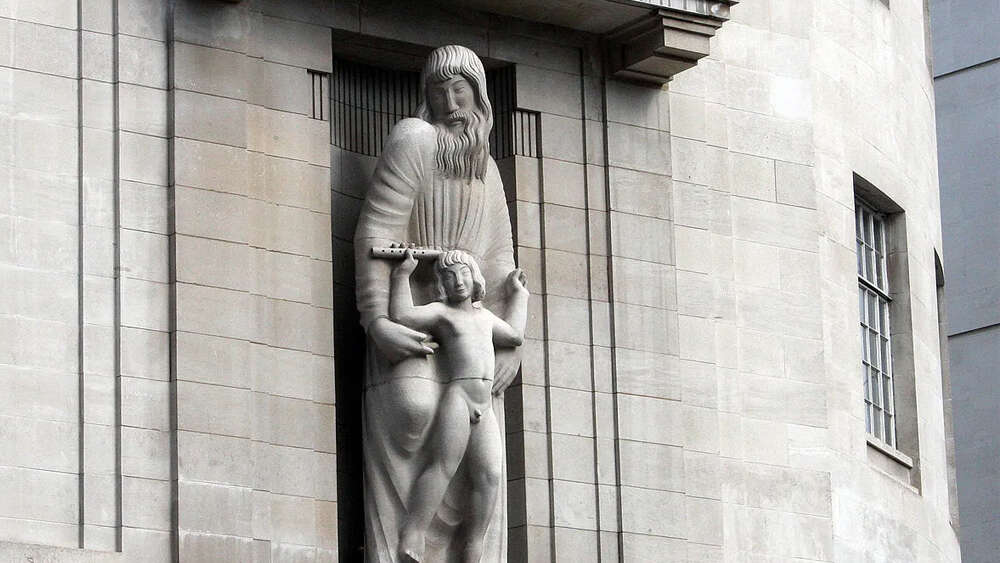Everyday Christian: Toppling statues, Prospero and Ariel at the BBC
Being a protestant sort, pilgrimages have not been part of my life*. But I guess a trip I made to the Printing Museum in London, behind St Brides Church in Fleet Street, sort of qualifies as one. As a typography enthusiast, I went in search of Eric Gill’s original drawings of the Gill Sans fonts, and I was lucky enough to meet a kind conservator who let me see them.
Typographic aside: I saw the drawings of Gill Sans Extra Bold, drawn in ink outlines which the craftsperson at the Monotype Corporation converted into metal. My favourite was Gill Sans Bold, but the Extra Bolds were close enough for the awestruck traveller I was.
Can one worship a typeface? Most of us typographic nutcases come pretty close.
But time was to reveal that the man was not to be worshipped.
Eric Gill, a stone carver, type designer, a sculptor, was also a leader of intentional communities in the third order of St Dominic, the designer of the magnificent Four Gospels and other Christian art.
And, when his diaries were published, especially in Fiona MacCarthy’s biography in 1989, Gill was revealed to be a sexual abuser of his daughters and the family dog.
This is why he made news this month when a protestor climbed up the facade of the BBC, opposite All Souls Church, to attack his statue of Prospero and Ariel, the characters from Shakespeare’s The Tempest.
(Gill himself asked, “Who are Prospero and Ariel, and why are they appropriate to the BBC?”)
Prospero, the magician, stands behind Ariel, the “spirit of the air” in the form of a naked boy.
Drawing attention to the BBC’s Jimmy Saville scandal (a TV presenter and child molester that used the BBC to gain access to children), Catherine Bennett, an Observer critic, comments, “Given this historical but probably indelible association with one of the UK’s most infamous pedophiles, it’s unfortunate the corporation’s flagship building should still double as a monument to another notorious British pervert, Eric Gill. Last week, Gill’s most famous public sculpture, Prospero and Ariel, was badly vandalised in front of an audience including various police officers and spectators from the BBC.” Her comments are the lead story in the Council of Australasian Museum Directors’ website
ARTNews reported “Katie Razzall, culture editor for BBC News, tweeted a video of the incident, writing: “Outside BBC right now a man is trying to smash up Eric Gill statue while another man live streams talking about pedophiles. Gill’s horrific crimes are well known. But is this the way?”
So along with Cecil Rhodes statue at Oxford (now protected by wire) and the statue of slave trader Edward Colston’s statue in Bristol (now toppled), Eric Gill’s statue is the site of protest.
Alongside colonialism and slave trading, Gill’s pedophilia is part of the new iconoclasm.
According to the BBC, QAnon UK has campaigned against the statue. It has featured in right-wing activist Tommy Robinson’s criticism of the BBC. The right, it seems, can use the same protest technique of attacking statues as the progressive left.
This incident adds a complicating layer to our cultural debates. Is a right-wing statue protest to be rejected but anti-colonialist ones accepted? Or the other way around? Gill’s statue has artistic merit, unlike the other two, another complication layer. The BBC uses Gill Sans. Should they stop?
Or is dividing cultural moments like the toppling of the Colston statue and the attack on Prospero and Ariel into neat groups, left and right, progressive or conservative, still possible any longer or even still desirable?
While Christians may have different responses to protests, we can – and should agree – that the re-examination of history inevitably involves a re-examination of sin. Of slavery, colonisation and pedophilia in these cases.
Seeing that sin marks out our culture in the form of monuments should not surprise us. Original sin is not an original thought.
The revelation that heroes – like Gill was once to me – have feet of clay is part of a Biblical worldview. Humans are all flawed. Especially those we are tempted to hero-worship. The Bible’s bleak description of the human race is correct, as is the glorious solution it contains.
The Bible’s description of “feet of clay” comes from Daniels’ vision of a statue representing the human kingdoms in his prophecy. It applies to all human heroes as well. The left-wing and right-wing protests that destroy or deface statuary remind me that the Bible is true.
* small inconvenient fact – I have walked the Via Francigena through Tuscany, Lombardy and Emilia Romagna, an ancient pilgrimage route.
Email This Story
Why not send this to a friend?



